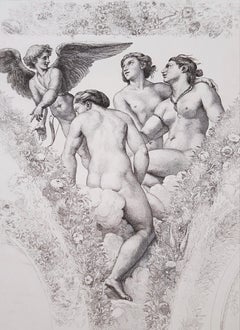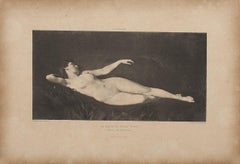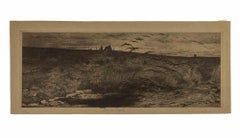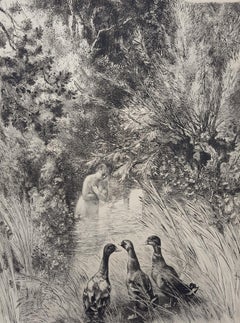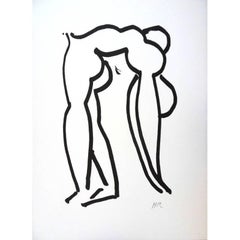1880s Nude Prints
to
3
4
2
2
4
4
2
3
3
Overall Height
to
Overall Width
to
2
1
1
4
3
3
2
1
1
1
1
1
1
1
1
1
1
1
1
1
1
1
18
47
1,811
752
22
84
143
70
56
174
219
414
225
123
10
1
1
1
3
3
2
1
1
Period: 1880s
L'Amour Montrant Psyche Aux Graces /// Renaissance Mythology Raphael Classics
By (after) Raphael (Raffaello Sanzio da Urbino)
Located in Saint Augustine, FL
Artist: (after) Raphael (Italian, 1483-1520)
Title: "L'Amour Montrant Psyche Aux Graces"
Portfolio: Gazette des Beaux-Arts
Year: 1883
Medium: Original Etching on chine appliqué on wo...
Category
Old Masters 1880s Nude Prints
Materials
Etching, Intaglio
Nude - Lithograph signed "Heuse" - 1880 ca.
Located in Roma, IT
Nude is an original lithograph signed "J. Heuse".
Signed on plate on the lower left.
Good condition except for some folding and being aged.
The artwork represents a nude figure in...
Category
Modern 1880s Nude Prints
Materials
Lithograph
Sad Hour - Original Etching by Attilio Zanchelli - Early 20th Century
Located in Roma, IT
Sad Hour is an Original Etching realized by Attilio Zanchelli.
The artwork is in good condition, included a cardboard passpartout (32x50 cm).
Edition of 20.
Attilio Zanchelli (186...
Category
Symbolist 1880s Nude Prints
Materials
Etching
Roman Stones - Original Lithograph after F. Mazois - 1880 ca.
Located in Roma, IT
Roman Stones is an original lithograph realized after the french architect François Mazois in 1880 ca.
Good conditions except for being aged with consumed margins.
The artwork rep...
Category
1880s Nude Prints
Materials
Lithograph
Canards Surpris (Surprised Ducks) /// Antique Impressionist Nude Animal Forest
Located in Saint Augustine, FL
Artist: Félix Bracquemond (French, 1833-1914)
Title: "Canards Surpris (Surprised Ducks)"
*Signed by Bracquemond in pencil lower right. It is also initial signed in ink lower left
Year: 1882
Medium: Original Drypoint Etching on cream Japanese paper
Limited edition: 100
Printer: Imprimerie Lemercier, Paris, France
Publisher: likely the artist Bracquemond himself, Paris, France
Reference: "Les graveurs du XIXe siècle: Guide de l'amateur d'estampes modernes", Vol. XII, Paris, 1885–1892 - Henri Béraldi: cat. No. 778; "Inventaire du Fonds Francais Apres 1800" - Jean Adhémar, Jacques Lethève: cat. No. 394, page 383; Laran No. 394
Framing: Recently framed in a gold Baroque moulding and rag matting from Holland
Framed size: 23.75" x 19.75"
Sheet size: 15.25" x 11.5"
Image size: 14" x 10.5"
Condition: In excellent condition
Notes:
"B" inscribed by Bracquemond in ink lower left. There is an example of this work in the permanent collection of the Metropolitan Museum of Art, New York, NY.
Biography:
Félix Bracquemond was born in Paris. He was trained in early youth as a trade lithographer, until Guichard, a pupil of Ingres, took him to his studio. His portrait of his grandmother, painted by him at the age of nineteen, attracted Théophile Gautier's attention at the Salon. He applied himself to engraving and etching about 1853, and played a leading and brilliant part in the revival of the etcher's art in France. Altogether he produced over eight hundred plates, comprising portraits, landscapes, scenes of contemporary life, and bird-studies, besides numerous interpretations of other artist's paintings, especially those of Jean-Louis-Ernest Meissonier, Gustave Moreau and Jean-Baptiste-Camille Corot. After having been attached to the Sèvres porcelain factory in 1870, he accepted a post as art manager of the Paris atelier of the firm of Haviland of Limoges. He was connected by a link of firm friendship with Édouard Manet, James McNeill Whistler, and all the other fighters in the impressionist cause, and received all the honors that await the successful artist in France, including the grade of Officer of the Legion of Honor in 1889.
Bracquemond was a prominent figure in artistic and literary circles in the second half of the 19th century. He was close to writers such as Edmond de Goncourt and critic Gustave Geffroy, and numbered among his friends Millet and Corot, Henri Fantin-Latour, Degas and the Impressionist circle, and Auguste Rodin. He was one of the more prolific printmakers of his time and he was awarded the grande medaille d'honneur at the Universal Exhibition of 1900. He was also a painter, ceramist, and an innovator in decorative arts. Gabriel Weisberg called him the "molder of artistic taste in his time". Indeed, it was he who recognised the beauty of the Hokusai woodcuts used as packing around a shipment of Japanese china, a discovery which helped change the look of late 19th-century art.
He married French Impressionist artist Marie Bracquemond...
Category
Impressionist 1880s Nude Prints
Materials
Etching, Intaglio, Drypoint
Le Lavement des Pieds - Lithograph d'Après Rembrandt by Léopold Flameng
Located in Roma, IT
Le Lavement des Pieds is an original artwork realized by Léopold Flameng in the second half of the XX century.
Etching on paper d'aprés Rembrandt.
Good conditions.
Passepartout in...
Category
Modern 1880s Nude Prints
Materials
Lithograph
Related Items
after Henri Matisse - Acrobat
Located in Collonge Bellerive, Geneve, CH
after Henri Matisse - Acrobat
Edition of 200
with the printed signature, as issued
76 x 56
With stamp of the Succession Matisse
References : Artvalue - Succession Matisse
Category
Modern 1880s Nude Prints
Materials
Lithograph
Picasso, Le Viol VII (after)
Located in Fairfield, CT
Artist: After Pablo Picasso (1881-1973)
Title: Le Viol VII (after Bloch 202)
Year: 1992
Medium: Reproduced from the original edition using the grain Autotype halftone screen process by Druck- und Verlag GmbH, 4200 Oberhausen, Germany; lithographically printed by Druck- und Verlag GmbH on japon handmade 200 g/sqm paper by created by Richard de Bas in Ambert, France and imported by Japico Drissler Feinpapiere, Frankfurt, Germany.
Paper Size: 18 x 12.75 inches; a size slightly reduced from the original Vollard edition for differentiation
Condition: Excellent
Inscription: Artist’s signature posthumously lithographically reproduced from the original Vollard edition, and numbered in pencil by the curators of the Municipal Museum Mülheim an der Ruhr, Germany. 168/300.
Notes: Published by Municipal Museum Mülheim an der Ruhr, Germany in cooperation with the Society for the Promotion of the museum in 1992 and the Fundación Picasso; printed by Plitt Druck- und Verlag GmbH, 4200 Oberhausen, Germany. The following is a German to English translation of the original text issued by the Municipal Museum Mülheim an der Ruhr, Germany in the following from which this graphic is a part, “In order to give a broad public access to this unique print work by Pablo Picasso in its entirety and at the highest quality level, the support group for the city. Museum Mülheim an der Ruhr initiated and significantly supported the new edition of the “Suite Vollard.” The reprint of the "Suite Vollard" includes a limited edition of 300 copies of 100 loose sheets each in a linen cassette. The copies were numbered from 1 to 300 on the leader sheet. The reproductions were produced in grain screen mode, a process in which which eliminates the traditional line grid and achieves maximum originality. The paper was hand-made specifically for this work by Richard de Bas in Ambert, France, one of the most traditional paper mills in Europe. The paper for the original edition also comes from this factory. The quality Blane narcisse, belin, 200 g/sqm was selected and imported from Japico Drissler Feinpapiere, Frankfurt. Reproduction and paper format has been slightly reduced compared to the original edition. The technical development and overall production was carried out by Plitt Druck- und Verlag GmbH, 4200 Oberhausen.”
PABLO PICASSO (1881-1973) Spanish painter and sculptor is one of the most recognized figures of twentieth century art. During his artistic career, which lasted more than 75 years, he created thousands of works using all kinds of mediums. He changed art more profoundly than any other artist of his time. First famous for pioneering cubism...
Category
Cubist 1880s Nude Prints
Materials
Lithograph
Nude drawing (Nude on her haunches draws )
Located in New Orleans, LA
A nude woman squats on her haunches as she draws an image on a sheet of paper. Joseph Hirsch created this lithograph in 1963 in an edition of 50. It was printed by Lucien Dutruit i...
Category
American Modern 1880s Nude Prints
Materials
Lithograph
Le Nu Aux Oranges - Color Lithograph - 2007 - Henri Matisse
Located in Sint-Truiden, BE
Color lithograph after the work by Henri Matisse, plate-signed by Matisse from the edition of 200.
This lithograph was printed and published in 2007 in Paris using 100% cotton 300 g...
Category
Fauvist 1880s Nude Prints
Materials
Lithograph, Handmade Paper
Nude IX - XXI Century, Contemporary Figurative Aquatint Etching Print
Located in Warsaw, PL
MARTA WAKUŁA-MAC: Master of Arts in Fine Art Education- Diploma in Fine Art Printmaking at the Institute of Art, Pedagogical University, Krakow, 2003. Member of Graphic Studio Dubl...
Category
Contemporary 1880s Nude Prints
Materials
Paper, Etching, Aquatint
Alexander Calder - Fete de L’Humanite - HAND SIGNED
Located in Brooklyn, NY
Sku: MI1151-B
Artist: Alexander Calder
Title: Fete de L’Humanite
Year: 1969
Signed: Yes
Medium: Lithograph
Paper Size: 32 x 22.5 inches ( 81.28 x 57.15 cm )
Image Size: 32 x 22.5 in...
Category
Contemporary 1880s Nude Prints
Materials
Lithograph
Marc Chagall - Moses - Original Lithograph
By Marc Chagall
Located in Collonge Bellerive, Geneve, CH
Marc Chagall, Original Lithograph depicting an instant of the Bible.
Technique: Original lithograph in colours
Year: 1956
Sizes: 35,5 x 26 cm / 14" x 10.2" (sheet)
Published by: Éditions de la Revue Verve, Tériade, Paris
Printed by: Atelier Mourlot, Paris
Documentation / References: Mourlot, F., Chagall Lithograph [II] 1957-1962, A. Sauret, Monte Carlo 1963, nos. 234 and 257
Marc Chagall (born in 1887)
Marc Chagall was born in Belarus in 1887 and developed an early interest in art. After studying painting, in 1907 he left Russia for Paris, where he lived in an artist colony on the city’s outskirts. Fusing his own personal, dreamlike imagery with hints of the fauvism and cubism popular in France at the time, Chagall created his most lasting work—including I and the Village (1911)—some of which would be featured in the Salon des Indépendants exhibitions. After returning to Vitebsk for a visit in 1914, the outbreak of WWI trapped Chagall in Russia. He returned to France in 1923 but was forced to flee the country and Nazi persecution during WWII. Finding asylum in the U.S., Chagall became involved in set and costume design before returning to France in 1948. In his later years, he experimented with new art forms and was commissioned to produce numerous large-scale works. Chagall died in St.-Paul-de-Vence in 1985.
The Village
Marc Chagall was born in a small Hassidic community on the outskirts of Vitebsk, Belarus, on July 7, 1887. His father was a fishmonger, and his mother ran a small sundries shop in the village. As a child, Chagall attended the Jewish elementary school, where he studied Hebrew and the Bible, before later attending the Russian public school. He began to learn the fundamentals of drawing during this time, but perhaps more importantly, he absorbed the world around him, storing away the imagery and themes that would feature largely in most of his later work.
At age 19 Chagall enrolled at a private, all-Jewish art school and began his formal education in painting, studying briefly with portrait artist Yehuda Pen. However, he left the school after several months, moving to St. Petersburg in 1907 to study at the Imperial Society for the Protection of Fine Arts. The following year, he enrolled at the Svanseva School, studying with set designer Léon Bakst, whose work had been featured in Sergei Diaghilev's Ballets Russes. This early experience would prove important to Chagall’s later career as well.
Despite this formal instruction, and the widespread popularity of realism in Russia at the time, Chagall was already establishing his own personal style, which featured a more dreamlike unreality and the people, places and imagery that were close to his heart. Some examples from this period are his Window Vitebsk (1908) and My Fianceé with Black Gloves (1909), which pictured Bella Rosenfeld, to whom he had recently become engaged.
The Beehive
Despite his romance with Bella, in 1911 an allowance from Russian parliament member and art patron Maxim Binaver enabled Chagall to move to Paris, France. After settling briefly in the Montparnasse neighborhood, Chagall moved further afield to an artist colony known as La Ruche (“The Beehive”), where he began to work side by side with abstract painters such as Amedeo Modigliani and Fernand Léger as well as the avant-garde poet Guillaume Apollinaire. At their urging, and under the influence of the wildly popular fauvism and cubism, Chagall lightened his palette and pushed his style ever further from reality. I and the Village (1911) and Homage to Apollinaire (1912) are among his early Parisian works, widely considered to be his most successful and representative period.
Though his work stood stylistically apart from his cubist contemporaries, from 1912 to 1914 Chagall exhibited several paintings at the annual Salon des Indépendants exhibition, where works by the likes of Juan Gris, Marcel Duchamp and Robert Delaunay were causing a stir in the Paris art world. Chagall’s popularity began to spread beyond La Ruche, and in May 1914 he traveled to Berlin to help organize his first solo exhibition, at Der Sturm Gallery. Chagall remained in the city until the highly acclaimed show opened that June. He then returned to Vitebsk, unaware of the fateful events to come.
War, Peace and Revolution
In August 1914 the outbreak of World War I precluded Chagall’s plans to return to Paris. The conflict did little to stem the flow of his creative output, however, instead merely giving him direct access to the childhood scenes so essential to his work, as seen in paintings such as Jew in Green (1914) and Over Vitebsk (1914). His paintings from this period also occasionally featured images of the war’s impact on the region, as with Wounded Soldier (1914) and Marching (1915). But despite the hardships of life during wartime, this would also prove to be a joyful period for Chagall. In July 1915 he married Bella, and she gave birth to a daughter, Ida, the following year. Their appearance in works such as Birthday (1915), Bella and Ida by the Window (1917) and several of his “Lovers” paintings give a glimpse of the island of domestic bliss that was Chagall’s amidst the chaos.
To avoid military service and stay with his new family, Chagall took a position as a clerk in the Ministry of War Economy in St. Petersburg. While there he began work on his autobiography and also immersed himself in the local art scene, befriending novelist Boris Pasternak, among others. He also exhibited his work in the city and soon gained considerable recognition. That notoriety would prove important in the aftermath of the 1917 Russian Revolution when he was appointed as the Commissar of Fine Arts in Vitebsk. In his new post, Chagall undertook various projects in the region, including the 1919 founding of the Academy of the Arts. Despite these endeavors, differences among his colleagues eventually disillusioned Chagall. In 1920 he relinquished his position and moved his family to Moscow, the post-revolution capital of Russia.
In Moscow, Chagall was soon commissioned to create sets and costumes for various productions at the Moscow State Yiddish...
Category
Modern 1880s Nude Prints
Materials
Lithograph
'Chamonix' Mid-Century Hand Signed Original Lithograph.
Located in Cotignac, FR
Mid-Century original lithograph entitled " Chamonix " hand signed by Joan Gardy Artigas and numbered 12/75 on arches vellum rag paper from the 1966-70 edition. Presented in period 19...
Category
Modern 1880s Nude Prints
Materials
Lithograph, Printer's Ink, Rag Paper
H 30.5 in W 14.75 in D 0.5 in
Original "Iced Lolly" vintage pop-art poster
Located in Spokane, WA
Original, horizontal, 1972, 'ICED LOLLY" created by the British artist Michael English. Printed in Harlow England.
This nude is melting the form ...
Category
Pop Art 1880s Nude Prints
Materials
Lithograph
'Eyes for the Night' — Mid-century Modernism
Located in Myrtle Beach, SC
Benton Spruance, 'Eyes for the Night', lithograph, 1947, edition 35, Fine and Looney 260. Signed, dated, titled, and annotated 'Ed 35' in pencil. A fine impression, on heavy, cream ...
Category
American Modern 1880s Nude Prints
Materials
Lithograph
Die Nacht (The Night), nude and cupids, German antique engraving
By Virgilio Tojetti
Located in Melbourne, Victoria
'Die Nacht'
(The Night)
German wood-engraving, 1903.
310mm by 230mm (image)
410mm by 280mm (sheet)
Category
Symbolist 1880s Nude Prints
Materials
Engraving
The Drunkard in Spring —after Gustav Mahler's 'The Song of the Earth'
Located in Myrtle Beach, SC
Arthur Paunzen, 'Der Trunkene im Frühling' (The Drunkard in Spring) from the suite 'Song of the Earth', etching, aquatint, and drypoint, 1920. Signed and titled in pencil. Signed in the plate, lower right. A fine, richly-inked impression, on cream, wove Japan paper; the full sheet with margins (2 1/4 to 4 1/4 inches), in good condition. Image size 12 3/8 x 9 1/8 inches; sheet size 19 5/8 x 13 5/8 inches. Matted to museum standards, unframed.
ABOUT THIS WORK
Pauzen’s suite of six etchings 'Das Lied von der Erde' (The Song of the Earth), published in 1920, was inspired by Gustav Mahler...
Category
Vienna Secession 1880s Nude Prints
Materials
Etching, Drypoint, Aquatint
Previously Available Items
Le Printemps
Located in New York, NY
A superb, richly-inked impression of this drypoint.
Category
Impressionist 1880s Nude Prints
Materials
Drypoint
Church of Milan - Original Etching by Mosé Bianchi - 1880
Located in Roma, IT
Church of Milan is an Original Etching realized by Mosé Bianchi in 1880.
The artwork is in good condition included a white cardboard passpartout (51x35 c...
Category
Symbolist 1880s Nude Prints
Materials
Etching
H 19.69 in W 13.59 in D 0.04 in
The Sensuality - Etching by Franz Von Stuck - 1889
By Franz von Stuck
Located in Roma, IT
The sensuality is an original etching on wove paper, realized by Franz Von Stuck in 1889.
Original title Die Sinnlichkeit . Hand-signed by the artist....
Category
Symbolist 1880s Nude Prints
Materials
Etching
Die Sinnlichkeit - Etching and Aquatint by Franz von Stuck - 1889
By Franz von Stuck
Located in Roma, IT
Die Sinnlichkeit is an original etching on wove paper, realized by Franz Von Stuck in 1889, hand-signed.
In very good conditions.
The artwork repres...
Category
Symbolist 1880s Nude Prints
Materials
Etching, Aquatint
H 20.87 in W 14.97 in D 0.08 in
La Vending - Etching by Joseph Apoux - 1880s
By Joseph Apoux
Located in Roma, IT
Image dimensions: 23 x 15.8 cm.
La Vendange is a black and white etching, drypoint and aquatint on laid paper, realized between the end of XIX century and...
Category
Modern 1880s Nude Prints
Materials
Etching
Mori me Cogis - Original Etching by Joseph Apoux - 1880s
By Joseph Apoux
Located in Roma, IT
Mori me cogis is an amusing black and white etching realized around 1880's by Joseph Apoux (1846-1910).
Signed on plate "Apoux" on the lower right corner, the title is inscribed on ...
Category
1880s Nude Prints
Materials
Etching
H 9.85 in W 10.63 in D 0.04 in
Recently Viewed
View AllMore Ways To Browse
Essex Ma
May Milton
Northern Michigan Art
Hermosa Beach
San Francisco Bay Bridge
Large 18th Century Landscape Oil
Impressionist Painting With Pink House
Red Haired Girl
Red Hair Girl
Alpine Scenes
Diamond Dust Bunnies
Impressionist Portugal
Portrait Bonaparte
P Camp
Monhegan Island Painting
Southwest Ceramics
Tools Native Americans Used
Scenic Screen
